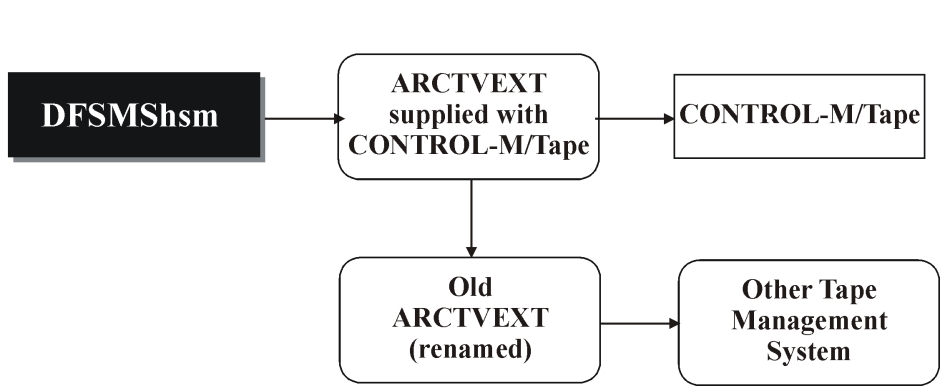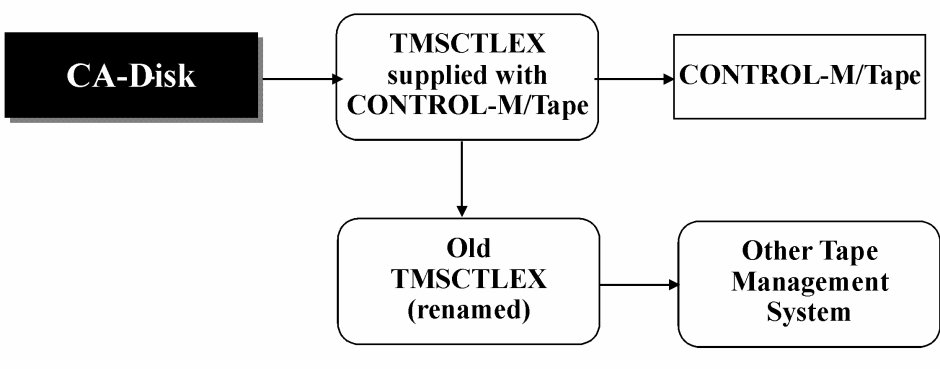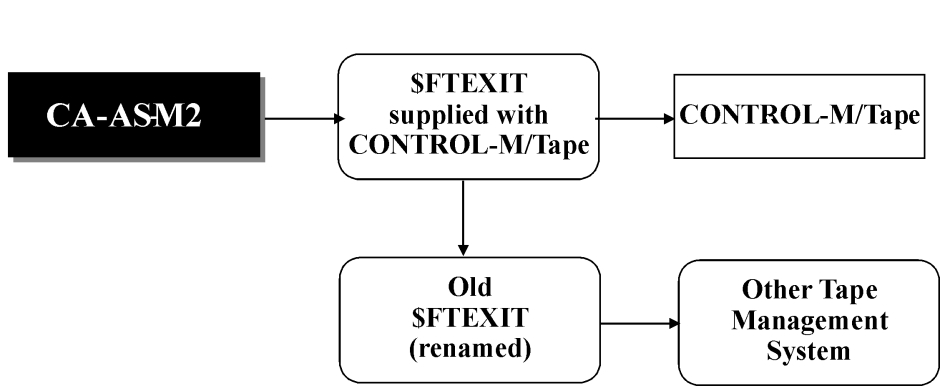External Data Managers
This chapter includes the following topics:
Overview
External Data Managers (EDMs) are programs that manage a specific set of volumes according to internal criteria. EDMs determine retention of the volumes they control and can optionally relate to one physical file as more than one logical file.
EDM volumes are identified to Control-M/Tape through DO RETENTION=EDM statements in Control-M/Tape rule definitions.
Below is a sample Control-M/Tape rule that identifies EDM controlled volumes. For more information about rule definition, the Control-M/Tape User Guide.
Figure 34 Sample Control-M/Tape Rule
RULE: DFHSM LIB CTT.PROD.RULES TABLE: EDM
COMMAND ===> SCROLL===> CRSR
-------------------------------------------------------------------------------
RULE NAME DFHSM GROUP MODE PROD (Prod/Test)
OWNER M72 SEQUENCE PRIORITY CONTINUE SEARCH Y (Y/N)
DESCRIPTION
DOCMEM DFHSM DOCLIB CTT.PROD.DOC
===========================================================================
ON DATASET = HSM* And/Or/Not
===========================================================================
DO RETENTION = EDM And/Or
DO POOL = DFHSM-TAPES
DO BMC recommends that you implement the Control-M/Tape interface to the EDM at your site while operating Control-M/Tape in Global Test mode. When Control-M/Tape is activated in Global Phased, or Global production mode, the interface to the EDM at your site must be active.
The EDM interface enables Control-M/Tape to detect when the EDM scratches a tape, so that Control-M/Tape can update the Media Database accordingly.
EDM volumes are managed at the volume level (meaning, no data set specific control is used).
If more than one data set is stored on an EDM volume, only the first data set on the volume is recorded in the Media Database.
If a data set spans more than one EDM volume, volume chaining is not recorded in the Media Database. Each volume containing part of the data set is recorded as a single (unchained) volume containing only that data set.
An EDM is allowed to create data sets only on scratch volumes, or on volumes that are already marked as EDM-controlled. If an EDM creates a data set on a scratch volume, that volume is then identified by Control-M/Tape as an EDM volume. Only an EDM is allowed to modify EDM volumes.
Information about EDM volumes listed in the Media Database can be displayed online through the Inquiry/Update screen (screen TI). For more information on the Inquiry/Update screen, see the online facilities chapter of the Control-M/Tape User Guide.
Data sets stored on EDM volumes are normally expired through a command from the EDM (meaning, not by instructions from Control-M/Tape or the other tape management system) according to the expiration mode (see Expiration Modes for EDM Volumes).
EDM volumes can also be expired manually through the Control-M/Tape utility CTTMUP. For more information, see the Control-M/Tape chapter of the INCONTROL for z/OS Utilities Guide.
The EDM interface is implemented through a user exit of the EDM. This exit enables Control-M/Tape (and optionally another tape management system) to detect when data sets or volumes are marked scratch by the EDM. Sample user exits for each EDM supported by Control-M/Tape are supplied with Control-M/Tape. The user exit used for each interface and the steps needed for its implementation of interfaces for the various EDMs are described on the following pages.
Control-M/Tape messages beginning with CTTEDM describe the operations performed through this interface.
Expiration Modes for EDM Volumes
The expiration mode for an EDM volume is defined as either immediate (IMMED) or deferred (DEFRD) in the sample user exit for that EDM volume. Default: Deferred.
If the mode is defined as deferred:
-
The EDM volume is marked in the Control-M/Tape Media database as pending scratched. The actual scratch is performed by the CTTRTM utility as part of the normal daily run of Control-M/Tape.
-
The volser of the scratched volume appears in the daily scratch report, but you must wait until after the next run of the CTTRTM utility to use the physical tape.
If the expiration mode is defined as immediate:
-
The EDM volume is immediately marked in the Control-M/Tape Media database as scratched after it expires.
-
The physical tape is immediately made available for use, but the volser for the scratched volume does not appear in the daily scratch report.
To change the default mode from IMMED to DEFRD:
-
While editing the sample user exit for the EDM interface you are implementing (as described in the following pages for implementing each EDM interface), search in the sample exit for the &EXPMODE parameter and change its value from D to I.
-
As part of the editing of the sample user exit, continue compiling the exit using the ICE Automatic Exit Installation Tool. For details about this tool, see the exits chapter of the INCONTROL for z/OS Administrator Guide.
DFSMShsm and ADSM Support
The Control-M/Tape interfaces for DFSMShsm and ADSM (ADSTAR Distributed Storage Manager) are identical. The same members and steps are used for both of these EDMs. However, for easier reading, the steps shown below mention only DFSMShsm.
The ARCTVEXT member in the IOA SAMPEXIT library is called by DFSMShsm whenever a tape volume no longer contains valid data. The exit marks the volume as scratch in the Media Database and, optionally, interfaces with an automated tape library at the site.
Figure 35 DFSMShsm Calling the ARCTVEXT Member
Use the following steps to implement the Control-M/Tape to DFSMShsm interface:
-
If you are currently not using Exit ARCTVEXT, continue with Step 2 below.
-
If this exit is already in use at your site (meaning, by another tape management system), use the following steps to integrate your current ARCTVEXT exit with Control-M/Tape’s exit in Global Test and Global Phased modes. You should stop using your other product’s ARCTVEXT exit when you first activate Control-M/Tape in Global Production mode.
-
Rename the load module of the ARCTVEXT exit currently in use at your site. You cannot have two exits with the same name in the DFSMShsm LOAD library.
-
Change all occurrences of keyword $TMSEXT$ in the ARCTVEXT sample member that is supplied with Control-M/Tape to the exit name you chose in Step A.
-
"Uncomment" the lines marked *CALLEXIT by replacing the asterisk in the first column with a space.
-
-
-
Install the DFSMShsm interface using the ICE Automatic Exit Installation Tool to compile the ARCTVEXT member. For details about this tool, see the exits chapter of the INCONTROL for z/OS Administrator Guide.
-
The EDM now calls the ARCTVEXT exit supplied with Control-M/Tape that in turn calls the old ARCTVEXT (that has been renamed).
Figure 36 DFSMShsm Calling the ARCTVEXT Member Supplied with Control-M/Tape
-
DFSMShsm receives a return code from the exit that communicates with the old tape management system. (This exit was originally named ARCTVEXT.)
-
-
Verify that the IOA LOAD library is defined as one of the DFSMShsm STEPLIB libraries or as one of the system’s LINKLIST libraries.
-
Make sure that DO RETENTION=EDM statements exist in rules for the data sets created by DFSMShsm, including the CDS backup data sets. This statement indicates that the data sets indicated in the rule's selection criteria are EDM-controlled. Job names, data set names and program names can be used as selection criteria by the rules. The following rule can be used:
CopyON DATASET = * AND
ON PGM = ARCCTL
DO RETENTION = EDMADSM invokes deletion Exit ARCTVEXT when it releases a tape. This exit, which is invoked in the ADSM address space, is identical to the ARCTVEXT exit used by DFSMShsm.
To disable the old ARCTVEXT exit and replace it with the new ARCTVEXT exit, issue the following commands in this order:
SETSYS EXITOFF(ARCTVEXT)
SETSYS EXITON(ARCTVEXT)You can use the CTTSYNC utility to list all inconsistencies between the Media database and the DFSMShsm OCDS file. You can run this utility occasionally, just to ensure that the two databases are synchronized.
CA-Disk (Formerly DMS/OS)
Use the steps described below to activate the CA-Disk interface to Control-M/Tape.
The TMSCTLEX exit is called by CA-Disk whenever a tape volume no longer contains any valid data. The exit marks the volume as scratch in the Media Database and, optionally, interfaces with the automated tape library at the site.
Figure 37 CA-Disk Calling the TMSCTLEX Member
-
If you are currently not using the TMSCTLEX exit, continue with Step2 below.
-
If this exit is already in use at your site (meaning, by another tape management system), use the following steps to integrate your current TMSCTLEX exit with the Control-M/Tape exit in Global Test and Global Phased modes. You should stop using your other product’s TMSCTLEX exit when you first activate Control-M/Tape in Global Production mode.
-
Rename the load module of the TMSCTLEX exit currently in use at your site. You cannot have two exits with the same name in the CA-Disk LOAD library.
-
Change all occurrences of keyword $TMSEXT$ in the TMSCTLEX sample member that is supplied with Control-M/Tape to the exit name you chose in step A.
-
"Uncomment" the lines marked *CALLEXIT by replacing the asterisk in the first column with a space.
-
-
-
Install CA-Disk Support using the ICE Automatic Exit Installation Tool to compile the TMSCTLEX member. For details about this tool, see the exits chapter of the INCONTROL for z/OS Administrator Guide.
-
The EDM now calls the TMSCTLEX exit supplied with Control-M/Tape that in turn calls the old TMSCTLEX (that has been renamed).
Figure 38 CA-Disk Calling the TMSCTLEX Member Supplied with Control-M/Tape
-
CA-Disk receives a return code from the exit that communicates with the old tape management system. (This exit was originally named TMSCTLEX.)
-
-
-
Verify that the IOA LOAD library is defined as one of the CA-Disk STEPLIB libraries or one of the system’s LINKLIST libraries.
-
Make sure that DO RETENTION=EDM statements are included in rules for the data sets created by CA-Disk. This statement indicates that the data sets indicated in the selection criteria of the rule are EDM-controlled. Job names, data set names, program names, or volsers can be used as selection criteria by the rules.
CA-ASM2 Support
Control-M/Tape and CA-ASM2 interface through CA-ASM2 Exit $FTEXIT (the Free Tape Exit). CA-ASM2 passes control to this exit before freeing a tape. In the sample for this exit supplied with Control-M/Tape (the AS2FTEXT member in the IOA SAMPLE library), the Control-M/Tape is called to expire the volume being freed (that is, to mark it SCRATCH in the Control-M/Tape Media Database).
Control-M/Tape does not need to communicate with CA-ASM2 Exit $NTEXIT (New Tape). If Control-M/Tape is the only tape management product installed at your site, verify that NONE is specified for the &TAPEMGT parameter of this exit before it is compiled.
Use the following steps to activate the CA-ASM2 interface for Control-M/Tape:
-
Define all CA-ASM2 controlled tapes as belonging to specific tape pools of Control-M/Tape (meaning, Control-M/Tape pools in which all tapes are controlled by CA-ASM2).
-
Definition of tape pools is not related to the value of the $TAPPOOL CA-ASM2 installation parameter. Tape pools must be defined for CA-ASM2 tapes regardless of whether CA-ASM2 tape pools are enabled. Pool definitions under Control-M/Tape ensure that only CA-ASM2 SCRATCH tapes are used by CA-ASM2 jobs.
-
-
If the $TAPPOOL parameter is equal to X'01' (meaning, CA-ASM2 tape pools are enabled), skip to Step 3 (below). Otherwise, define rules that instruct Control-M/Tape to use only tapes from these pools for data sets created by CA-ASM2.
-
The data set names in the rules you define must be identical to those that appear in MOUNT messages for the relevant volumes. If you changed the "Dummy" data set name (written as the first file on each CA-ASM2 tape), use the new name in the rules as well.
-
-
Use the ICE Automatic Exit Installation Tool to compile the $FTEXIT member. For details about this tool, see the exits chapter of the INCONTROL for z/OS Administrator Guide. The $FTEXIT member is called by CA-ASM2 whenever a tape volume no longer contains valid data. The exit marks the volume as scratch in the Media Database and, optionally, interfaces with the automated tape library at the site.
Figure 39 CA-ASM2 Calling Exit $FTEXIT
-
If you are currently not using Exit $FTEXIT, continue with Step4 below.
-
If this exit is already in use at your site (that is, by another tape management system), use the following steps to integrate your current $FTEXIT exit with Control-M/Tape’s exit in Global Test and Global Phased modes. You should stop using your other product’s $FTEXIT exit when you first activate Control-M/Tape in Global Production mode.
-
-
Rename the load module of the $FTEXIT exit currently in use at your site. You cannot have two different exits with the same name in your CA-ASM2 LOAD library.
-
Change all occurrences of keyword $TMSEXT$ in the $FTEXIT sample member that is supplied with Control-M/Tape to the exit name you chose in StepA.
-
"Uncomment" the lines marked *CALLEXIT by replacing the asterisk in the first column with a space.
-
Run the ASMFTEXT job (described above).
Figure 40 CA-ASM2 Calling Exit $FTEXIT Supplied with Control-M/Tape
-
CA-ASM2 now calls the $FTEXIT exit supplied with Control-M/Tape that in turn calls the old $FTEXIT (that has been renamed).
-
CA-ASM2 receives a return code from the exit that communicates with the old tape management system. (This exit was originally named $FTEXT.)
-
-
Verify that the IOA LOAD library is defined as one of the STEPLIB libraries or one of the system’s LINKLIST libraries.
-
Make sure that DO RETENTION=EDM statements are specified in rules for the data sets created by CA-ASM2. This statement indicates that the data sets indicated in the selection criteria of the rule are EDM-controlled. Job names, data set names, program names, or volsers can be used as selection criteria by the rules.
ExHPDM Support
Use the steps described below to implement the Control-M/Tape to ExHPDM interface.
The SOVCTTEX exit is called by ExHPDM whenever a tape volume no longer contains valid data. The exit marks the volume as scratch in the Media Database and, optionally, interfaces with an automated tape library at the site.
-
Install ExHPDM Support using the ICE Automatic Exit Installation Tool to compile the SOVCTTEX member. For details about this tool, see the exits chapter of the INCONTROL for z/OS Administrator Guide.
-
Verify that the IOA LOAD library is defined as one of the ExHPDM STEPLIB libraries or as one of the system’s LINKLIST libraries.
-
-
Make sure that DO RETENTION=EDM statements are specified in rules for data sets created by ExHPDM. This statement indicates that the data sets indicated in the rules selection criteria are EDM-controlled. BMC recommends that you include the ON PGM=SOVMAIN statement as a selection criteria in the rules.
-
Verify that ExHPDM PTF L1P013W has been applied.
-
Specify the following statement in the ExHPDM startup parameter file: TMS(CONTROLT)
FDR/ABR Support
Use the following steps to implement the Control-M/Tape to FDR/ABR interface.
The CTTFDR exit is called by Archive Maintenance Utility FDRARCH whenever a tape volume no longer contains valid data. The exit marks the volume as scratch in the Media Database and, optionally, interfaces with an automated tape library at the site.
-
Install FDR/ABR Support using the ICE Automatic Exit Installation Tool to compile the CTTFDR member. For details about this tool, see the Exits chapter in the INCONTROL for z/OS Administrator Guide.
-
Verify that the IOA LOAD library is defined as one of the FDRARCH STEPLIB libraries or as one of the system’s LINKLIST libraries.
-
-
Make sure that DO RETENTION=EDM statements are specified in rules for data sets created by FDR/ABR. These statements mean that the data sets indicated in the rules' selection criteria are EDM-controlled. Job names, data set names, and program names can be used as selection criteria by the rules.
-
The following rules can be used as an example:
CopyON PGM = FDRABR andON JOBNAME = ARCH* andON DATASET = *
DO RETENTION = EDM
ON PGM = FDRARCH andON JOBNAME = REORG andON DATASET = *
DO RETENTION = EDM
-
-
Specify the following statement as an FDRARCH control statement:
CopyDEFAULT EDMEXITNAME=CTTFDR






 Communities
Communities Support Center
Support Center YouTube
YouTube Twitter
Twitter Facebook
Facebook LinkedIn
LinkedIn